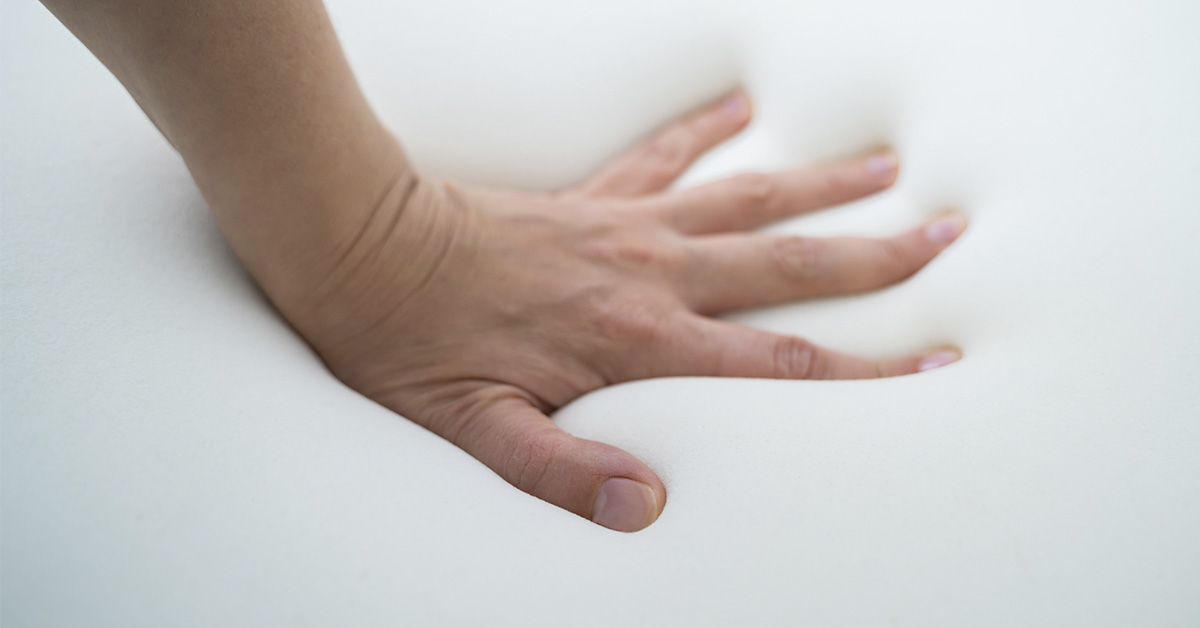There are many types of mattresses, but memory foam has recently boomed in popularity. They provide a unique sleeping experience since they can mold to people’s sleeping positions, which can relieve pressure and pain in their backs, hips, and shoulders. However, memory foam’s popularity dropped as people learned about the potentially toxic chemicals used during manufacturing. Fortunately, safety regulations have changed the manufacturing of these mattresses today.
The History of Memory Foam
Memory foam was developed by NASA in the 1960s. They wanted to make seat cushions to protect the pilots from vibrations and crashes. Eventually, the material became used in hospital beds to help prevent bedsores. Then, in the 1990s, the company TempurPedic put the first memory foam mattress on the market.
At first appearance, these mattresses seem smooth and firm. But when they are activated by heat, they sink and mold around the body’s shape. In addition to providing relief and support, memory foam inhibits motion transfer, so partners are less likely to wake each other as they move around.
To create this unique surface, memory foam contains different ingredients depending on type and company. However, they all tend to contain these basic additions: polyols, diisocyanates, and blowing agents. Polyols are molecules that are essentially the building blocks of this material. Diisocyanates are chemical compounds that react with polymers to make polyurethane foam. And blowing agents aid the chemical reaction that creates the foam. In the past, companies may have used more toxic blowing agents, but most today use water.
However, blowing agents were not the only toxic chemicals used in past memory foam mattresses. In fact, the original renditions could contain an assortment of them, such as:
- Methylbenzene, more commonly known as toluene, is toxic when large amounts are inhaled.
- Formaldehyde is known as a carcinogen. Its fumes can irritate people’s nose, mouth, and eyes.
- Methylene Dianiline may also be carcinogenic, and it can irritate skin that touches it.
- Methylene Chloride, also potentially carcinogenic, can be harmful to humans when it comes into contact with unprotected skin and mucous membranes.
- Chlorofluorocarbons, when emitted, can cause damage to the ozone layer. [1]
The Chemicals Used Today
Fortunately, companies have stopped using many of these substances as research exposed their potentially harmful effects. Today, memory foam mattresses are considered safe, and their chemicals are generally stable when customers bring them home. Companies don’t publicize the exact ingredients they used since they prefer to keep their recipe a trade secret. But most choose to have third-party organizations test the foam for safety.
This is especially important since not all toxic chemicals are banned. Some have begun to use green materials like soybean oil instead of petrochemicals, making their mattresses contain less potentially toxic substances. Additionally, the Federal Trade Commission (FTC) has recently become vigilant regarding exposing companies that claim to use non-toxic ingredients without any evidence to prove it.
However, all mattresses must legally contain some kind of fire barrier. So many companies use a chemical flame retardant. Because of the complications regarding testing and regulating these kinds of chemicals, it’s very possible that some flame retardants used have harmful properties. For instance, polybrominated diphenyl ethers (PBDEs) were extremely common flame retardants.
Now, research links them with cancer, obesity, infertility, and developmental brain disorders. Other examples include boric acid, which may also cause infertility, and melamine compounds, which can have formaldehyde. To protect yourself from these kinds of fire barriers, look for mattresses with safety certifications from third-party organizations. You could also choose mattresses that use non-toxic fire barriers like Kevlar, wool, or silica-treated rayon.
The Safety of Memory Foam Mattresses
One major deterrent of memory foam is off-gassing, the foul smell that appears when foam mattresses are unboxed. It’s caused by releasing volatile organic compounds (VOCs) into the air. VOCs are, unfortunately, a vital part of memory foam, even in those made with green materials. Cheaper-quality mattresses may have a stronger smell.
Off-gassing may irritate the eyes, noses, and throats. But fortunately, the VOCs go away after a few hours or days. So open the box in a room with good ventilation. Then let it air out before sleeping on it. Good quality mattresses with third-party certifications usually contain negligible amounts of VOCs and similar chemicals.
Here’s another tip for mattress shopping: If it’s too good to be true, it probably is. Cheap mattresses are more likely to contain more toxic chemicals. For memory foam mattresses, in particular, their regulations are updated frequently depending on new discoveries about chemicals.
Therefore, newer memory foam mattresses are more likely to follow higher safety standards. Older ones may contain ingredients no longer in use. It’s more expensive to buy from reputable companies, but if they are transparent about how they make their mattresses, the products will likely be good quality.
Even though memory foam is generally safe, some people may have trouble with it, like those with asthma, allergies, or other respiratory issues. Similarly, some parents may choose mattresses with more natural materials for their children. (Keep in mind, babies or young kids shouldn’t sleep on memory foam.) Instead, try natural alternatives like natural latex. [2]
Sources
- “Is Memory Foam Toxic?” Sleep Foundation. Lauren Fountain. March 11, 2022.
- “Blue Shift: Why You Don’t Need to Worry About Your Foam Mattress Off-Gassing.” Wirecutter. Leigh Krietsch Boerner. April 20, 2016.

